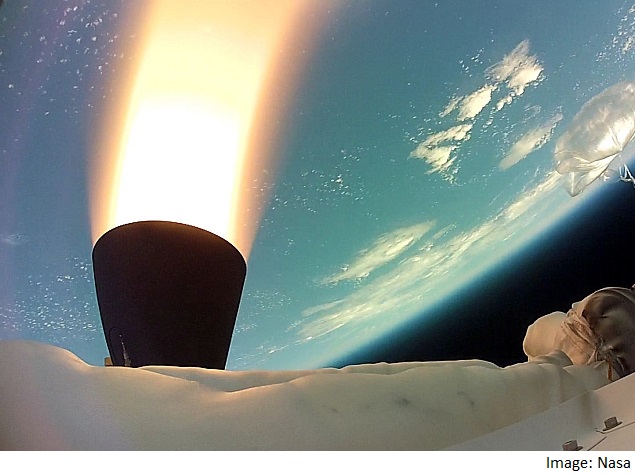- Home
- Science
- Science News
- Nasa 'Flying Saucer' Test Flight Delayed Again Due to Bad Weather
Nasa 'Flying Saucer' Test Flight Delayed Again Due to Bad Weather

Nasa had to postpone weekend launch attempts of the the balloon-borne rocket-powered craft from a test range in Hawaii due to weather concerns. Nasa on its blog said it would evaluate a Monday launch opportunity.
The saucer-shaped Low Density Supersonic Decelerator (LDSD) is designed to demonstrate technologies that are likely to come into play for delivering heavy payloads to Mars.
The craft is equipped with an inflatable, doughnut-shaped shield as well as a super-strong parachute that should slow the LDSD down from supersonic speeds during descent.
A high-altitude balloon has to carry the LDSD aloft to a height of 120,000 feet from the US Navy's Pacific Missile Range Facility on the Hawaiian island of Kauai. The LDSD would be dropped from there, and then its rocket engine would be fired to take it even higher, up to 180,000 feet.
(Also See: Nasa Planning Manned Mars Mission for 2030s)
On the way up, the LDSD would hit a top speed of Mach 4, or four times the speed of sound. On the way down, the doughnut-shaped cushion, called the Supersonic Inflatable Aerodynamic Decelerator (SIAD), would be inflated to a diameter of 20 feet.
The SIAD is designed so that atmospheric drag slows the craft down from Mach 3 to about Mach 2.4.
The test parachute would then unfurl to slow the descent even more, so that the LDSD platform falls gently into the Pacific Ocean for recovery.
Nasa said such drag devices should be capable of delivering two to three tonnes of payloads safely to the Martian surface. Current technologies limit Nasa's Mars payloads to about a tonne.
The LDSD's first flight test took place a year ago and successfully tested the inflatable drag shield. The parachute, however, tore itself apart, resulting in a harder-than-expected splashdown.
Since then, the parachute has been redesigned to be stronger and much more robust.
This year's follow-up test could have taken place earlier this week. But the waves in the Pacific were too high to ensure the safety of the crew members who would have to recover the LDSD after splashdown.
The waves settled down later in the week, but then winds became a concern.
Get your daily dose of tech news, reviews, and insights, in under 80 characters on Gadgets 360 Turbo. Connect with fellow tech lovers on our Forum. Follow us on X, Facebook, WhatsApp, Threads and Google News for instant updates. Catch all the action on our YouTube channel.
Related Stories
- Samsung Galaxy Unpacked 2025
- ChatGPT
- Redmi Note 14 Pro+
- iPhone 16
- Apple Vision Pro
- Oneplus 12
- OnePlus Nord CE 3 Lite 5G
- iPhone 13
- Xiaomi 14 Pro
- Oppo Find N3
- Tecno Spark Go (2023)
- Realme V30
- Best Phones Under 25000
- Samsung Galaxy S24 Series
- Cryptocurrency
- iQoo 12
- Samsung Galaxy S24 Ultra
- Giottus
- Samsung Galaxy Z Flip 5
- Apple 'Scary Fast'
- Housefull 5
- GoPro Hero 12 Black Review
- Invincible Season 2
- JioGlass
- HD Ready TV
- Laptop Under 50000
- Smartwatch Under 10000
- Latest Mobile Phones
- Compare Phones
- Realme P4x 5G
- OnePlus Ace 6T
- OPPO A6x 5G
- Samsung Galaxy Z TriFold
- Poco F8 Ultra
- Poco F8 Pro
- Huawei Mate 80 RS Master Edition
- Huawei Mate 80 Pro Max
- Asus ProArt P16
- MacBook Pro 14-inch (M5, 2025)
- Poco Pad M1
- Poco Pad X1
- Just Corseca Skywatch Pro
- Honor Watch X5
- Acerpure Nitro Z Series 100-inch QLED TV
- Samsung 43 Inch LED Ultra HD (4K) Smart TV (UA43UE81AFULXL)
- Asus ROG Ally
- Nintendo Switch Lite
- Haier 1.6 Ton 5 Star Inverter Split AC (HSU19G-MZAID5BN-INV)
- Haier 1.6 Ton 5 Star Inverter Split AC (HSU19G-MZAIM5BN-INV)
-
 Anthropic Releases New Claude Tool That Interviews Users About Their AI Usage
Anthropic Releases New Claude Tool That Interviews Users About Their AI Usage
-
 ACT Fibernet Launches Revamped Broadband Plans Starting at Rs. 499
ACT Fibernet Launches Revamped Broadband Plans Starting at Rs. 499
-
 Motorola Edge 70 Special Edition Launched in Pantone’s 2026 Colour of the Year with Swarovski Accents
Motorola Edge 70 Special Edition Launched in Pantone’s 2026 Colour of the Year with Swarovski Accents
-
 Apple Announces App Store Awards 2025 Winners; Top Apps Include Tiimo, Cyberpunk 2077: Ultimate Edition, and More
Apple Announces App Store Awards 2025 Winners; Top Apps Include Tiimo, Cyberpunk 2077: Ultimate Edition, and More











